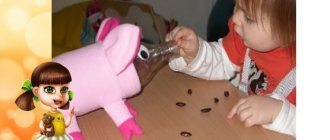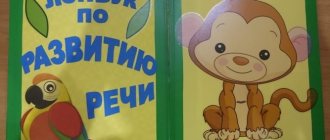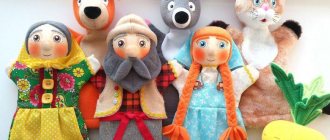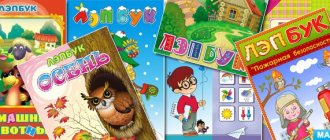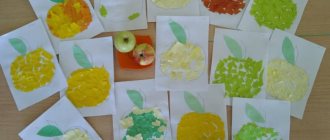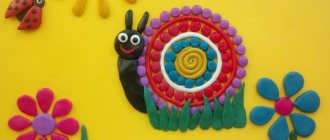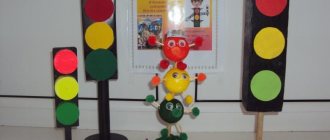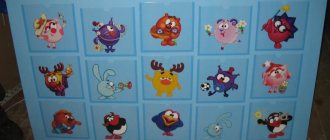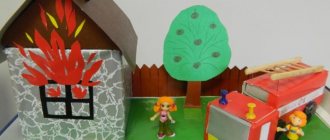OOD progress:
(Children sit on chairs)
Educator: Look, today we have many guests - these are kindergarten employees. Let's wish everyone a good morning (children greet guests)
.
Now listen to me carefully, everyone.
Today I want to play a fairy tale with you. Do you remember why Baby Geo went on his journey? (children's answers)
Yesterday, for example on April 1, he sent an SMS message saying that he had gone to Lake Ice. There he found and completed all the tasks of the jester Dwan and will return to us on April 2. Can you guess when this will happen (children's answers)
That’s right, today, but I haven’t seen him yet, apparently he’s on his way.
Guys, he also reminded me that I need to help his friends write a letter.
Are you willing to help? (children's answers)
To do this we need to get to the Castle of Transformations! Shall we try? (children get up and approach the drawn castle)
.
Educator: Look, the gate to the Castle is locked. Let's try to open it (I suggest several different keys)
.
What's the matter? That's right, it's a combination lock. How can we open it? Code, what is code? (children's answers are a set of numbers that only the owner knows)
.
Wait, wait, I think I guessed it: a code card-badge with three identical numbers on it, which Baby Geo left for me when he went to Ice Lake. Look at it and name the code (children call 555, set the code and “open”
lock).
Educator: Great, now that we’re in the castle we can help Baby Geo’s friend. Now you will go to your rooms (to the tables, the table number corresponds to your badge number)
.
Physical minute: If you have fun, do this (clap in front of yourself)
If you have fun, do this (clap in front of yourself)
We boogie-boogie, turning in circles (turning around)
And we all do it together like this (clapping overhead)
If you have fun, do this (turn to the sides)
If you have fun, do this (turn to the sides)
We boogie-boogie, turning in circles (turning around)
And we all do it together like this (squats)
Next I tell a fairy tale, the children perform transformations of a square.
Educator: Little Geo left a portrait of a friend in each room. Take the portrait out of the envelope, get to know him, say his name (children's answer is Square)
.
And what can a square tell about itself (children’s answers: it is two-colored, it has four sides, all sides are equal, the angles are right, it can be folded diagonally, in half).
Well done, I see that you are ready to play a fairy tale with me, to become my assistants. Ready? (children's answers)
Educator: I remind you of the rules of the game: be attentive, try to independently help the main character of the fairy tale; if you have completed the task, do not shout, raise the green circle and show it, I will notice; if you need help, raise red and you will be helped; be well-mannered.
So: I say the magic words - “Fish-crucian game has begun”
Attention to the screen (I show the presentation and accompany it with text):
“In the most ordinary city, in the most ordinary house, lived a very ordinary family: mother Triangle, father Krug, and their son Square. He didn’t have any brothers or sisters, but he did have grandfather Quadrangle, who lived in another city. Grandfather lived far away, because it was necessary to get to him by land, by water and even by air. That’s what dad said. Grandfather Quadrangle often wrote letters. One day at breakfast, dad said that yesterday he again received a letter from grandfather. Grandfather says hello to everyone, wishes everyone good health and asks what his beloved grandson Kvadrat dreams of becoming. In their response, dad Krug and his son Kvadrat wrote to their grandfather about Kvadrat’s dream.” I am telling one of the methodological fairy tales (“The Secret of the Raven Meter, or the Tale of the Amazing Adventures and Transformations of the Square”). (together with the children we construct objects from a two-color Square).
Who is V.V. Voskobovich and his educational games
Voskobovich Vyacheslav has a higher education and is a physicist. He is considered the first author of educational games, during which a child’s creative skills are formed, mental processes, sensory skills, and creative thinking develop. They became available to a wide range of people back in the late 90s of the last century.
Vyacheslav Vadimovich was forced to engage in this type of activity by vital necessity and love for his children. During “perestroika” it was almost impossible to buy good toys, and the young father had two options: invent something himself or let the development of his children take their course.
He chose the only correct path and independently began to look for ways to solve the problem that had arisen. His inspiration was the work and practice of the famous early development methods of Nikitin and Zaitsev. Thus, Voskabovich’s games appeared, which not only gave children an interesting pastime, but also influenced their overall development.
To date, there are more than 50 games using this method. Each of them is a separate instruction on the development of skills and abilities of children of different age categories, which they receive easily and naturally in an interesting playful way.
Games using the Voskobovich method are multifunctional and contribute to all-round development. At the same time, the child learns the science of reading and counting more easily. Logical and creative thinking and memory develop. Enough attention is paid to creative development.
Every game follows three basic principles.
- Any game is associated with a journey into a fairy tale, in which the child not only imagines fairy-tale characters, but also helps them overcome obstacles and solve emerging problems.
- Gaming moments with benefit. Voskobovich's educational games are multifunctional. With their help, they develop not only counting and reading skills, but also logical thinking, memory and other psychological processes. Training and development are linked together continuously.
- Growth of creativity. Each game develops the creative side of the baby (imagination, fantasy), which contributes to the early development of creative thinking.
Voskobovich's games can be used for children aged two years and older. They can begin with an introduction to the basic elements, and end with multi-level mathematical or logical problems.
Educational games Voskobovich article on mathematics on the topic
Educational games by Voskobovich
The first games of Vyacheslav Voskobovich appeared in the early 90s. Basically, these are construction games and puzzles, accompanied by fairy-tale plots.
The most famous of them are “Geokont” and “Voskobovich Square”.
Games develop design abilities, spatial thinking, attention, memory, creative imagination, fine motor skills, the ability to compare, analyze and contrast. There are also more complex games that teach children to model and relate parts and the whole.
In such games, children comprehend theory through practice. The author has also created manuals aimed at learning numbers (for example, “The Magic Eight”) and letters (“Letter Constructor”), and for learning to read (for example, using the universal textbook “Folds”). Voskobovich's games are multifunctional and are intended for children from 2 to 10 years old (although they can be up to 99 years old).
A little history
Vyacheslav Vadimovich Voskobovich - lives in St. Petersburg. He has developed more than 40 educational games and manuals. In the past, Vyacheslav Vadimovich was an engineer-physicist.
The impetus for the invention of games came from two of his own children and “empty” toy stores during the era of Perestroika. Voskobovich, trying to find an alternative to the usual post-Soviet toys, came across the experience of Nikitin and Zaitsev, but decided to go his own way. This is how his first creative games appeared: “Geokont”, “Game Square”, “Color Clock”.
“We abandoned “disposable” products: assembled, disassembled and put aside, we create universal games that can be creatively used repeatedly,” says Vyacheslav Voskobovich.
A little later it was created for the development, production, implementation and distribution of methods and developmental and correctional games.
Goals of classes with Voskobovich game materials
• Development of the child's cognitive interest and research activity.
• Development of observation, imagination, memory, attention, thinking and creativity.
• Harmonious development of emotional-imaginative and logical principles in children.
• Formation of basic ideas about the surrounding world, mathematical concepts, sound-letter phenomena.
• Development of fine motor skills.
Features of Voskobovich's educational games
— The games are designed based on the interests of children.
By playing with such gaming aids, children get real pleasure and discover more and more new opportunities for themselves.
— Wide age range.
Children from 2 to 7 years old and older can play the same game.
The game begins with simple manipulation and then becomes more complex due to a large number of different game tasks and exercises.
— Multifunctionality and versatility.
By working with only one game aid, the child has the opportunity to show his creativity, develop comprehensively and master a large number of educational tasks (get to know numbers or letters, colors or shapes, counting, etc.).
— Ready-made educational didactic material, systematized by age and educational objectives.
— Methodological support.
Many games are accompanied by special methodological books with fairy tales, in which various plots are intertwined with intellectual tasks, questions and illustrations. Fairy tales and their good heroes - the wise raven Meter, the brave little Geo, the cunning but simple-minded Vse, the funny Magnolik - accompanying the child through the game, they teach him not only mathematics, reading, logic, but also human relationships.
Voskobovich's most popular games
“ Geokont ” - it is also called a “plate with nails” or “multi-colored cobwebs” -. It is a plywood board with a coordinate film applied to it. Plastic nails are attached to the playing field, onto which multi-colored “dynamic” elastic bands are pulled. As a result of this design, object silhouettes, geometric shapes, patterns, numbers, and letters are obtained.
The game set is accompanied by the methodological fairy tale “Little Geo, Raven Meter and Me, Uncle Slava” (the word “geometry” is encrypted in the title of the fairy tale).
And the fairy tale begins like this: “One day, little Geo had a dream. He walks around the world for a day, a second, a third, and suddenly he meets the Red Beast. The kid got scared, ran, and suddenly - a voice: “Don’t be afraid of the Red Beast, drive him away with an orange cry.” The baby shouted with an orange cry - the Red Beast disappeared, but a tree appeared, on the top of which the Yellow Bird sat. The Yellow Bird flapped its wings and circled, the Kid got scared and ran. And again the voice: “Don’t be afraid of the Yellow Bird - drive it away with a green whistle.” The baby whistled with a green whistle - the Yellow Bird disappeared. A lake appeared and a boat stood on the shore. The Kid got into the boat, made a few strokes, and suddenly a Blue Fish swims out. The Kid got scared again and leaned on the oars, but that was not the case. And again the voice: “Don’t be afraid of the Blue Fish, drive him away with a blue whisper.” The Kid whispered in a blue whisper - the lake disappeared, the boat disappeared. Geo stood in front of the entrance to the Violet Forest."
Thus, the baby does not just create images on Geokont, but makes the web of the Yuka spider, rays and segments, which are called the “orange cry of the Red Beast,” “the green whistle of the Yellow Bird,” or the “blue whisper of the Blue Fish.” The book contains diagrams and drawings of what a child should achieve.
As a result of playing with “Geokont”, children develop motor skills of the hand and fingers, sensory abilities (mastering color, shape, size), mental processes (designing according to a verbal model, constructing symmetrical and asymmetrical figures, searching for and establishing patterns), and creativity.
“Voskobovich Square” or “Game Square” can be 2-color (for children 2-5 years old) and 4-color (for 3-7 year old children)
The game consists of 32 rigid triangles, glued on both sides at a distance of 3-5 ml from each other on a flexible fabric base. On one side the “Square” is green and yellow, on the other – blue and red. The “square” is easily transformed: it can be folded along fold lines in different directions according to the “origami” principle to obtain three-dimensional and planar shapes. That is why this game is also called “Eternal Origami” or “Transformer Square”.
The game is accompanied by a methodological tale “The Mystery of the Raven Meter, or the tale of the amazing transformations and adventures of a square.” In it, “Square” comes to life and turns into various images: a house, a mouse, a hedgehog, a kitten, a boat, a shoe, an airplane, candy, etc. The child collects figures from pictures in a book that shows how to fold a square and gives an artistic depiction of the same object.
This square puzzle not only allows you to play, develop spatial imagination and fine motor skills, but is also a material that introduces the basics of geometry, steriometry, counting material, the basis for modeling, creativity, which has no age restrictions.
"Miracle=crosses" is a game with inserts. The inserts are made of circles and crosses. The crosses are cut into pieces in the form of geometric shapes. At the initial stage, children learn to assemble cut shapes into a single whole. Further, the task becomes more complicated: according to the diagrams in the “Album of Figures” (attached), the child first collects paths, towers, and then dragons, men, soldiers, insects and much more.
The game develops attention, memory, imagination, creativity, “sensory” (distinguishing the colors of the rainbow, geometric shapes, their size), the ability to “read” diagrams, compare and make a whole from parts.
“The ship “Splash - Splash ” is a playing field made of carpet in the form of a ship with a glued plywood hull and printed numbers from 1 to 7. To the mast on the hull you need to attach the colors of the rainbow and the required number of velcro flags - sails. The game develops fine motor skills, attention, memory, thinking, gives an idea of mathematical concepts, color, height, spatial arrangement of objects, conventional measurement, number of objects, their serial number and digital series.
“Math Baskets” - this manual will help your child literally “touch” counting, understand the composition of numbers, and also understand the meaning of addition and subtraction. The baby needs to put a certain number of mushroom inserts into baskets with different numbers of recesses. According to the fairy tale, a child, together with the little animals: Hedgehog-One, Bunny-Two, Mouse-Three and others, collects mushrooms in baskets, counts them, distributes an equal number of mushrooms to the animals and checks who has full baskets and who doesn’t. The animals collect mushrooms, and the baby finds out who has collected more and who has collected less.
“Funny Letters” are cards with images of the vowels of the Russian alphabet in the form of acrobat jesters: the first jester curved like the letter A and his name is Harlequin, the other jester twisted like the letter O and his name is Orlekin, U appears to be Urlekin, there are also Jarlekin, Yrlekin, Yurlekin, etc. By playing with cards and singing the names of jesters, the child becomes familiar with letters and practices sound analysis of words; develops attention, memory, thinking, imagination and speech.
"Voskobovich's Teremki" is a unique tool for teaching reading on a visual basis. The game consists of 12 wooden chest cubes of different colors (2 white, 2 blue, 2 yellow, 2 purple, 2 brown) with consonant letters on the edges, as well as 12 cardboard chest cubes (2 blue, 2 green, 6 double blue -green, 2 symbolic) with vowels on the edges, which are put into tower cubes to form syllables. And from several “teremki” you can make a word.
At the first stage of the game, the child becomes familiar with sounds and letters. On the faces of the first white cube there are the letters B, P, V and F. The child turns the cube in different directions and names the sounds. Then he comes up with what animals could live in this little house: a butterfly, a parrot, a wolf, an eagle owl. In the same way, the child gets acquainted with the rest of the “teremkas”.
Now the insert cubes with jester vowels are connected. The blue cube contains A, O, U, E, Y (vowels showing the hardness of the sound), and the green cube contains I, Yo, Yu, I, E (vowels showing the softness of the vowel sound).
At the second stage, we learn to form syllables. We put a cube with the letter A into the first “terem” and read the resulting syllable: “Pa.”
At the third stage, you can compose and read simple words. The device of the tower cubes allows you to turn the process of learning to read into a series of exciting games. For example, a game of “transformers”, where “house” can easily become “smoke”, and “ice” into “honey”.
"Folding boxes." Voskobovich reworked the idea of Zaitsev's warehouses, who created cubes with warehouses.
The game-aid “Skladushki” is intended for teaching children to read in a storage system.
The manual is made in the form of a book, on each page there is a bright picture and a poetic caption with highlighted sections. There is also a CD with voiced warehouse songs, for example, one of them:
Goose and goose There were only a dozen goslings. The goose and the goose were shortchanged. Everyone was there.
What you should pay attention to when working with your child on Voskobovich’s games:
• Preparation. Before offering the game to your child, read the guidelines and the game itself.
• Speech. Mostly children work with their hands and speak little. During classes, ask your child what he is doing, why he chose this particular figure and not another, ask him to retell the fairy tale task or come up with his own plot.
• Static. When engaging with play materials, the child is most often in the same sitting position. It is necessary to take into account the age characteristics of children and promptly distract them from sitting for too long.
• Perseverance. Playing with Voskobovich's manuals requires perseverance, and not every child likes or is able to do this.
The secret of Voskobovich's technique
In fact, the whole secret of the technique lies in simplicity - the simpler the toy, the more you can do with it. Well, imagine for yourself - let's say, a school class for Barbie or a dollhouse - these are beautiful, complex toys, but you can only play one game with them.
And remember your childhood in the sandbox, how you built entire cities and countries with your own hands, organized knightly tournaments, played Cossack robbers (and some, probably, even knives). Simple toys require a lot of effort from children, which is why they are so attractive from an early development point of view.
Voskobovich's toy is a square divided into isosceles right triangles. Typically, one side of the square is painted in one color, and the other in a contrasting color.
This helps the baby explore space. There are also special instructions for the square - various diagrams and suggestions on what and how you can play with your child using the square.
Voskobovich himself was extremely far from psychology and pedagogy, but he loved his own children very much, but, unfortunately, at that time there were practically no high-quality educational toys.
Therefore, the talented physicist came up with and made such toys for his children. The main principles of his methodology were in such aspects as:
- the opportunity to play for the benefit of the child;
- development of ideas about the world through unique fairy tales;
- an opportunity to awaken creativity in a child.
The essence of the technique
We learn by playing
In the game process, the child immediately receives several developmental moments at the same time: counting and reading, attention and imagination, logic and memory. This way we get comprehensive development. The author takes an interesting fairy tale as a basis.
So, in his opinion, the child will receive educational information in a fun and relaxed way. Each game has its own fairy tale, with its own heroes who need to be helped by completing certain tasks and exercises. A child and an adult, or later, the child himself, can play both according to the proposed scenario and develop his creative abilities and come up with new characters, new plots and new riddles.
Three pillars of gaming technology
Today, Voskobovich’s method includes about 50 games. Each of them is a universal creative tool that makes a child's learning fun and relaxed. This is achieved thanks to the fairy-tale orientation of all games, in which the main characters help children remember numbers, shapes and letters.
Much attention is paid to Voskobovich’s technology and the development of the child’s creative abilities. Performing unusual tasks forces him to use his imagination and be creative.
Thus, all games are developed on three important principles: interest - cognition - creativity.
Creation
Another principle of the “Fairy Tale Mazes Game” technology is the early creative development of preschool children. The game creates conditions for creativity and stimulates the development of the child’s creative abilities. An adult can only use this natural need to gradually involve children in more complex and creative forms of play activity.
Methods for implementing the “Fairy Tale Mazes Game” technology
The peculiarities of the technology are such that there is no need to rebuild the work of the institution, break the usual way of life and build a new one. Technology is organically woven into the already familiar rhythm of life and the educational objectives of the implemented program. The only difficulties the teacher faces are stereotypes of his own behavior. The game does not imply domination of the adult over the child in the “adult-child” relationship; it dictates partnerships. Did the teacher used to be the child’s partner in our kindergartens? It wasn't, and for many reasons. These are groups that are too “large” and these are also pedagogical postulates that had to be followed.
In preschool institutions using our technology, the child is surrounded by a relaxed, cheerful, intellectual and creative atmosphere that does not evoke negative emotions. Like lace from thin threads, it is woven from a feeling of external security, when the child knows that his manifestations will not receive a negative assessment from adults, and a feeling of internal relaxation and freedom due to the support of adults for his creative endeavors.
A few words about Voskobovich
Vyacheslav Vadimovich is a physicist by education. He was forced to plunge into pedagogy by vital necessity and love for his own children. He raised them during the difficult times of “perestroika,” when he couldn’t afford to buy high-quality educational toys, and there was still no assortment. Realizing that he had two options - to let the children’s development take its course or to create something himself, he chose the second option. And, inspired by the works of Zaitsev and Nikitin, Vyacheslav Vadimovich developed his own set of games, which can provide not only leisure for children, but also their full development.
Master class on making a Voskobovich square with your own hands
There are several options for how to make a square yourself. More details about each.
Option 1
This option is the simplest. You will need to prepare:
- colored cardboard;
- scissors;
- ruler;
- pencil;
- glue;
- wide tape or transparent self-adhesive film.
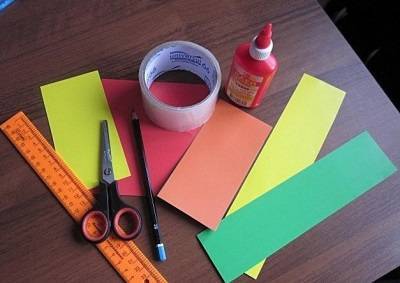
How to do:
- Choose contrasting colors for the triangles. If you are making a two-color square, then red and green sheets of cardboard will be enough. If you decide to make a four-color square, you will need red, green, blue and yellow sheets.
- Draw the required number of triangles on the cardboard. For two-color you need 16 pieces of each color, for four-color - 8 pieces. You can use standard triangle sizes (6*4.5*4.5 cm), or you can make your own.
- Cut out the triangles.
- Based on the size of the triangles, decide on the size of the base. For standard sizes, the base will be 15*15 cm. If you use a different size of triangles, then take into account the distance between them of 0.5-1 cm.
- Glue the triangles together in pairs with contrasting colors: blue-yellow, red-green. There should be 16 triangles in total.
- Next, if you use tape, glue the triangles together on both sides, according to the number of colors chosen for the square.
- If you use film, first measure the dimensions of the base of the square. On the base, arrange the squares in the required sequence. Fold the film along the top border and carefully glue the squares on the other side. You will have a solid base for your square. If you use tape, there will be many connection points.
The guide is ready. You can start folding.
Option 2
You will need:
- plain, easily folded fabric for the base;
- colored self-adhesive paper;
- scissors;
- ruler:
- pencil.
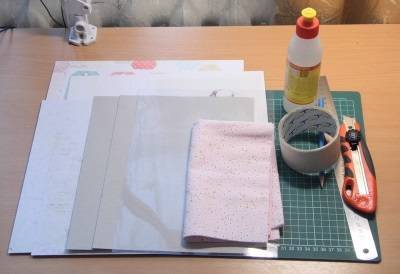
How to do:
Prepare the base of the required size
Please note that the edges of the fabric should not fray. Treat them if necessary. Cut isosceles triangles from self-adhesive paper. Place the triangles on the base to avoid mistakes when gluing. Now gradually separate the protective paper layer from each triangle and glue it to the base.
The dimensions of the triangles and the base, the color combination are described in detail in option 1.
Option 3
This option is made entirely of fabric. You will need:
- plain, easy-to-flex fabric in a neutral color (such as white or black) for the base;
- colored fabric for triangles;
- if desired, you can use white cardboard to add rigidity;
- glue gun, thread, sewing machine.
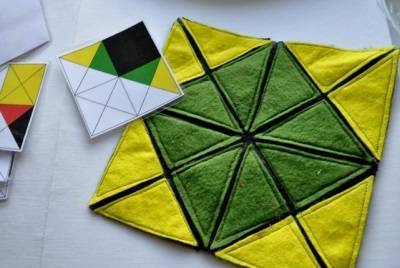
How to do:
- Prepare the base. If necessary, trim the edges of the fabric.
- Cut out the required number of triangles from colored fabric.
- You need to cut out 32 triangles, slightly smaller in size, from cardboard.
- Assembling a square. We glue cardboard triangles onto the base using a glue gun, and glue fabric triangles on top of them.
- To add strength, sew the edges of the triangles using a sewing machine.
All the necessary sizes and color selection can be seen in the first version of the Voskobovich square.
In addition to games with such a square, Voskobovich offers another game “Transparent Square”.
How to make a square with your own hands
All you need to create an educational toy with your own hands is a piece of flexible, durable material and bright, durable triangles. The easiest and safest way to make this toy is to sew it from fabric.
It will be pleasant to the touch, flexible and at the same time very durable (much stronger if folded, for example, from paper). In order to make a more rigid version, you can take a piece of thick cardboard (or thin plastic) and flexible non-marking fabric for the base.
Having made the pattern, you just need to glue the triangles on both sides to the base. You can also watch a master class on making a square from other available materials.
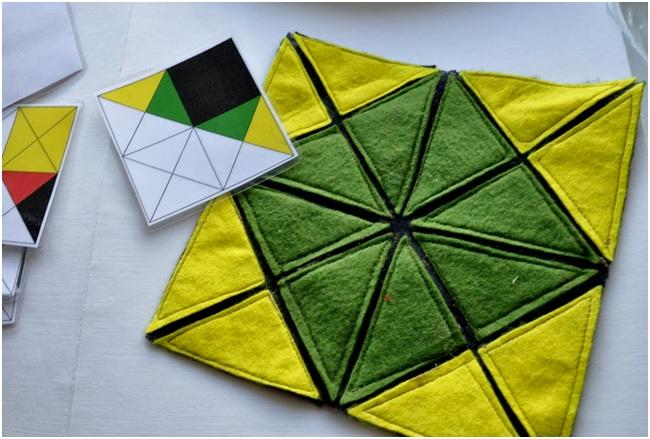
What to do next
Games using the Voskobovich method allow the child to get acquainted with the world around him, but sooner or later the child will outgrow this wonderful toy. Then it makes sense to have other exciting toys using the Voskobovich method - by the way, they are also easy to make with your own hands, but if you wish, you can buy ready-made ones.
With the help of such games, you can improve your child’s logical and spatial thinking, teach him basic arithmetic skills, and introduce him to modeling and spatial geometry.
I also want to note that it is very important to develop the child evenly. You shouldn’t go into some narrow area; it’s best when the baby is in harmony
This means that from time to time he needs to learn abstract thinking.
By developing a child harmoniously, you can achieve great heights - his creative potential will grow, and his creative and intellectual abilities will increase and improve.
Did you like our content? Subscribe to the channel in .
A little about V. Voskobovich
Vyacheslav Vladimirovich Voskobovich, receiving an education as an engineer-physicist, did not even imagine that he would have to immerse himself in pedagogy. He had to do this for the upbringing and comprehensive development of his sons. In the early 90s, during perestroika, there were very few high-quality games in stores; not everyone could afford to buy them. Therefore, when he became a father, he thought about creating his own games that would be interesting not only to his sons, but also to their peers. Studying the works of Zaitsev and Nikitins helped him in this.
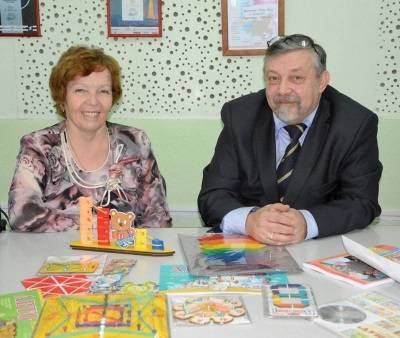
The games he created helped not only diversify children’s pastime, but also contributed to their full development.
After a short amount of time, a . It is there that games are developed and produced, and he is also involved in the dissemination and implementation of the methodology.
Educational games
Having such manuals, you can simulate different and endless options for playing with them.
Inventions are beginning to give more and more imagination to new ones, so we can get acquainted with such play sets as:
Geokont, a construction game, but unique. The nails are arranged on a wooden board in a certain order and colored rubber bands are included in the kit. At first glance, I personally found it uninteresting. But if we take a closer look, we find ourselves with the child in the fascinating world of geometry and travel with the heroes Uncle Slava, Mater the raven and others. We study colors and shapes, fantasize using the attached diagrams and invent our own.
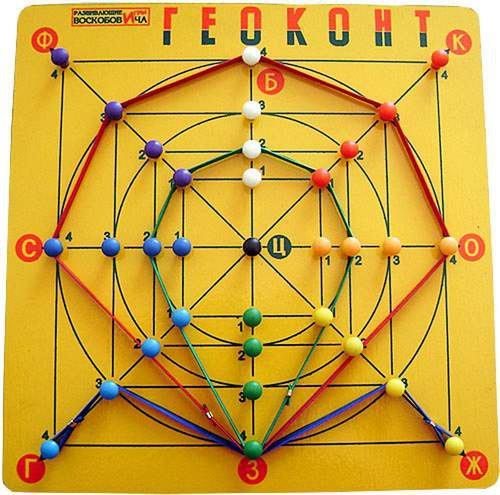
Voskobovich square. Plastic triangles on a fabric basis in two or four colors. The set includes a book - instructions describing the magic figures that can be assembled using this square.
Folding boxes
- Methodical tales
- Sensory country "Purple Forest"
- Miracle puzzles: miracle - crosses, miracle - flowers, miracle - honeycombs
- Labyrinths of letters and numbers
- Teremki for teaching reading from 3 years (cubes with inserts)
- Insert Games
- Laces
- A boat for teaching numbers and counting “Bul-Bul” and “Splash-Splash”
- Cards with letters. A peculiar alphabet, somewhat similar to the alphabet of S. Lupan
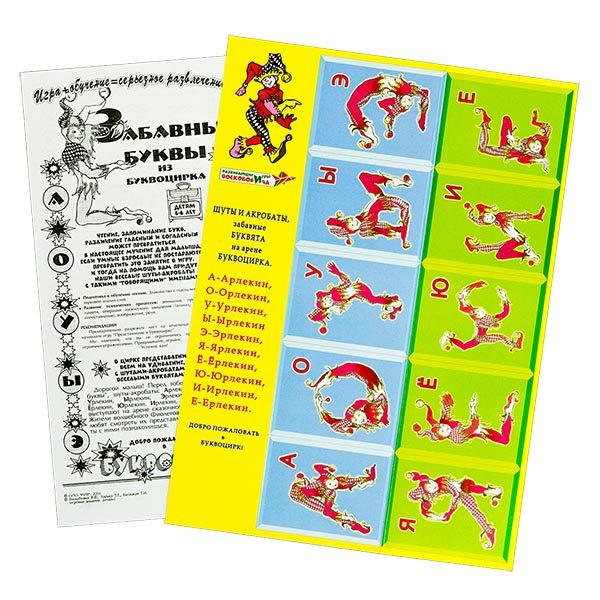
They reveal his creative potential, imagination, normalize his mental background, and all this by immersing the child in the fantastic world of fairy tales and adventures. Now his developments are successfully used in preschool and school institutions. They are also freely available for sale and can be easily practiced at home, which can keep your child occupied for a long time and free up precious time for mom.
A development center of the same name has been opened, Voskobovich Educational Games LLC, which is engaged in the production and development of manuals.
Voskobovich games for children's development
Voskobovich's games - for children's development
During childhood, all children should play. Through games, children learn about the world around them. Thanks to various educational games, the process of learning about the world is more exciting and faster, and favorable conditions are created for the development of intellectual and creative potential for the child.
Teachers in our kindergarten use the Voskobovich method to develop intellectual and creative potential. His methodology is based on fairy tales and entertaining gameplay.
Educational games are multifunctional: you can teach reading, counting, writing, develop logic, memory, thinking and mental processes.
All games according to Voskobovich’s method can be divided into several types. Most of them develop logical and mathematical abilities (the ship “Plyukh-Plyukh”, the constructor “Geokont”, “Voskobovich’s Square”, “Digital Circus” and others), teach reading (“Letter constructor”, “Reader on balls”, “Voskobovich’s Towers” ", "Snowman"). The games are accompanied by methodological books with tasks, fairy tales, illustrations and questions. Good heroes (the cunning but simple-minded Vse, the wise raven Meter, the funny Magnolik, the brave Geo) accompany the child and teach not only mathematics and reading, but also human relationships.
Construction game "Geokont".
The construction set is presented in the form of a board with nails arranged in a certain sequence. The playing field comes with a set of colored rubber bands and a manual containing tasks of varying difficulty levels. Children don't just complete boring tasks, but go on a real journey with Geo and help him overcome various obstacles in the Purple Forest by constructing geometric shapes. The description of Voskobovich's technique (attached to the game) offers diagrams of the drawings that should be obtained in the end. The game "Geokont" introduces children to the world of geometry, helps them study colors, shapes and sizes, teaches them to model, fold according to a pattern, think outside the box, look for similarities and differences, and develop fine motor skills.
"Voskobovich Square"
The “transformable square” consists of thirty-two multi-colored triangles, which are applied to a fabric base and located at a certain distance from each other. The game is designed for ages from two to five years (two-color square), and for older children there is a four-color square. The square can be transformed to create different shapes. You can assemble according to the proposed schemes or come up with your own. There are more than a hundred options. The educational game according to Voskobovich’s method is accompanied by a fascinating fairy tale “The Mystery of the Raven Meter” and teaching aids. Fairy-tale characters will help your child solve problems: dad Rectangle, grandfather Quadrangle, baby Square and others. The game develops abstract thinking and the ability to navigate in space, instills modeling skills, develops perseverance, memory and attention, and creativity.
Puzzle "Miracle crosses"
Voskobovich's method and game is a multifunctional tool for developing mathematical abilities. The game is presented in a frame with different inserts that differ from each other in color and shape. All figures are divided into parts. First, the child is asked to assemble the fragments into a single whole, and as the first successes appear, the tasks become more complex. For example, you can offer to collect different images of objects. For clarity, the set includes an album of figures. “Miracle crosses” form a child’s concepts of whole and part, help him master shapes and colors, and develop the ability to analyze and compare. During the game, the child learns to use diagrams to solve certain problems.
The ship "Plush-Plush"
While playing with a colorful boat with sails that can be put on wooden yards, tactile sensations and fine motor skills are developed. The numbers from one to five are printed on the base of the toy. You need to attach a certain number of flags to the mast, having previously sorted them by size and color. While playing with the boat, the child will meet sailor Frog and Captain Goose, who will tell about their exciting adventures. This multifunctional game, which is used as part of development according to the Voskobovich method, introduces the child to different colors and develops initial mathematical skills. In addition, the process develops skills in sorting objects, taking into account their color and quantity.
"Math baskets"
“Math baskets” will help strengthen counting skills, explain the composition of numbers, teach how to perform simple mathematical operations and compare numbers. In addition, fine motor skills develop while completing tasks. During the game, the child helps fairy-tale characters put mushrooms into baskets. You need to find out who collected more and who collected less, how many mushrooms need to be put in so that the basket is full, and so on. The author’s methodological manual describes more than ten different games with “Math Baskets”.
Lacing game “Chamomile”
“Chamomile” will help you compose and read new words, develop fine motor skills, reading skills, intelligence and enrich your vocabulary. Using a string on a thick base, you can make up about two hundred words. For younger children, the material is used simply as lacing to develop fine motor skills.
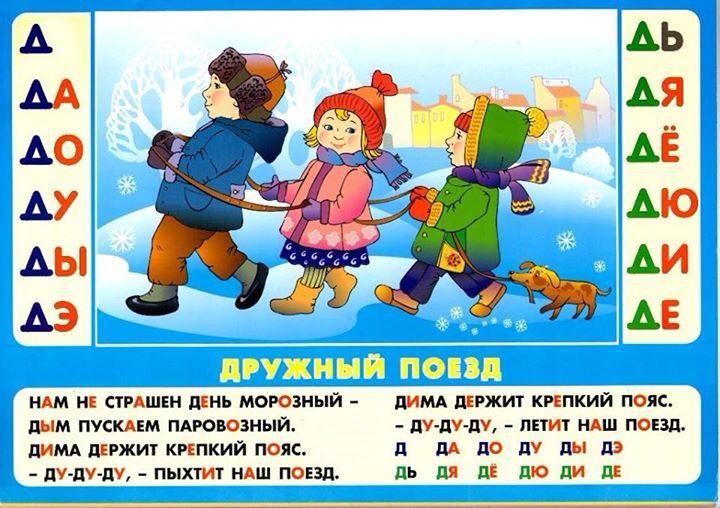
Allowance "Folding boxes"
A colorful teaching aid will introduce your child to consonants and vowels, and will also allow you to master the principle of adding syllables. During the game you will meet many characters, with whom you can learn songs and poems. The game comes with a CD of songs that you can listen to periodically. During the training process, various analyzers are involved: auditory, visual and tactile. The benefit improves memory, develops attentiveness and perseverance.
Teremki Voskobovich
A unique instructional model is used to prepare for early reading. Judging by the reviews, this is a very interesting technique. "Teremki" enriches vocabulary, develops fine motor skills, creativity and mental processes. In a playful way, the child learns to connect letters into syllables and transform syllables into words. The manual includes twelve multi-colored towers on which sounds are written. Each cube is equipped with an arch or window for vowels. To connect letters into a syllable, you need to put a certain chest in the corresponding house and sing the formed syllable. This manual, which is used as part of training using the Voskobovich method, is accompanied by detailed instructions describing the games.
"Magic Gonziki"
A fun game develops acting talent, fine motor skills, attention and memory, and can also help in remembering the names of all fingers. This is also good psychological help: a child can put on a Gonzik and answer an adult’s questions not on his own behalf, but on behalf of a fairy-tale character, talk about the problems of the Gonzik (in fact, the problems of the child himself). There are a lot of games with fairy-tale characters, and Voskobovich’s method is good. Gonziki will help you learn rhymes, memorize and repeat actions, and develop fine motor skills. The game is suitable for children from two to seven years old.
Carpet "Larchik"
The carpet grapher occupies a special place in Voskobovich’s methodology - this is a unique author’s manual that is free from many of the shortcomings of the school board. The carpet adheres well to the contact tape, which allows you to securely fasten visual material, and original elements (pockets, ropes, circles, clips) ensure dynamic learning. The manual provides scope for the activities of teachers and is suitable for group and individual lessons. The tasks are grouped by age. For each age, the methodological manual provides various tasks for the development of memory, attention, thinking, creativity, there are tasks in mathematics, teaching literacy and developing speech. The carpet includes the playing field itself made of carpet (1.2 m x 1.2 m), on which a grid is applied. The set includes special clips so that the rug can not only be placed on the floor, but also hung on the wall. There are five multi-colored ropes made from contact tape, twenty-five Velcro, ten blank multi-colored cards, cards with letters and numbers, ten cardboard cards with funny letters and the same number with interesting animal numbers.
Pros and cons of the technique
Many children's institutions have quite successfully tested Voskobovich's method of work - this is confirmed by numerous positive reviews. Children usually complete all tasks with interest and great desire. The positive results of using original educational games in the educational process were not long in coming. The only disadvantage of Voskobovich’s method is the fact that manuals, games and teaching materials must be purchased in specialized stores. It is impossible to make original games yourself.
Results of use
The use of Voskobovich's technique in kindergarten promotes the development of attentiveness, memory, creativity, thinking, observation, and develops the child's interest in knowledge and research activities. Thus, the harmonious development of the logical and emotional-imaginative principles is ensured, initial knowledge about the world around us is formed, and fine motor skills develop. Research conducted in preschool educational institutions using the Voskobovich method showed that in the 2nd junior group, children distinguish and name colors, know geometric shapes, can navigate planes, have no problems with counting and begin to read earlier. The issue of readiness for school appears to be resolved.
About the most famous
All Voskobovich games can be divided into several types:
- developing logical and mathematical abilities (“Geokont-constructor”, “Voskobovich Square”, the boat “Plyukh-Plyukh”, “Digital Circus”, etc.);
- teaching reading (“Voskobovich’s Teremki”, “Reader on Balls”, “Snowman”, “Letter Constructor”).
"Geocont"
It is a plywood board on which a coordinate grid is depicted and 33 plastic nails are nailed. The game also comes with “webs” - multi-colored rubber bands and an illustrated manual with multi-level tasks and extraordinary journeys of the heroes.
This game is an excellent tool for training fine motor skills, and also helps to remember colors, shapes, develops the ability to model, navigate a coordinate system, compare diagrams, and teaches you to think outside the box.
It’s easy to make with your own hands using any board and push pins.
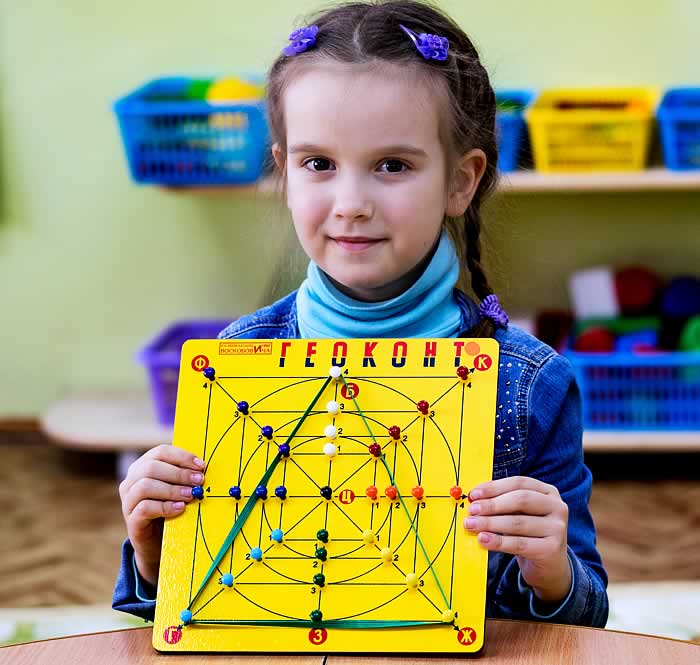
"Voskobovich Square"
It is also called the “Game Square”, “Maple Leaf”, “Eternal Origami”. This is a flexible field on which 32 plastic triangles are glued in two or four colors (depending on the difficulty of the game).
The unique design allows you to transform a square into a huge number of flat and three-dimensional shapes with different patterns. Two-year-olds can easily assemble a house or a hedgehog, while older children work according to the schemes suggested in the application or invent their own images.
Together with mother Trapezium and a whole family of geometric figures, the child learns to design, model, think abstractly and navigate in space.
The ship "Plush-Plush"
Made in the form of a model of a five-masted ship, “Plyukh-Plyukh” will appeal to children aged 2 years. Instead of sails, it has colored flags that can be strung on wooden yards. This alternative to the pyramid will teach you to count, distinguish colors, and deal with fine motor skills.
He also has a brother “Splash-Splash” - the idea is the same, only in this case the boat is glued to the carpet and the sails are with Velcro.
"Chamomile"
For kids 2-3 years old it will be an excellent lacing trainer, and for older children it will help them form words. By the way, you can come up with up to 200 of them! This is such a simple but entertaining game.
"Letter constructor"
It is one of the best tools for successfully memorizing letters. Consists of a plywood base and rubber bands that hold the elements of the letters. A fun way to take a fresh look at learning the alphabet.
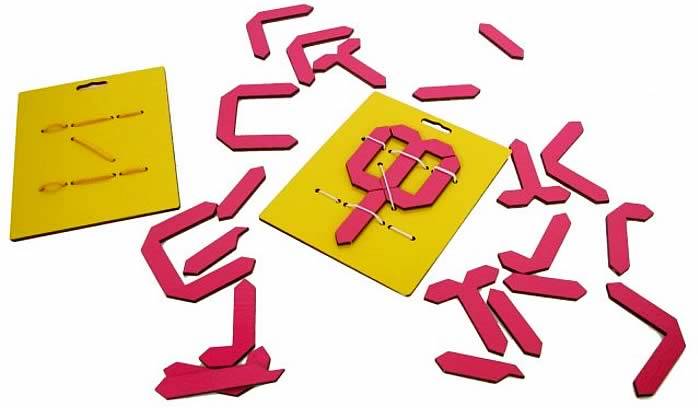
"Teremki"
Another great simulator for learning to read. The set includes cubes representing vowels and blocks with consonants. To get a syllable, you need to place a vowel in the tower. And if you connect the towers, you can form a word.
To memorize letters faster, Vadim Vyacheslavovich created each one with its own unique image. For example, vowels are indicated by fairy-tale characters - jesters.
Learning to read occurs in three stages: memorizing letters - adding syllables - composing words.
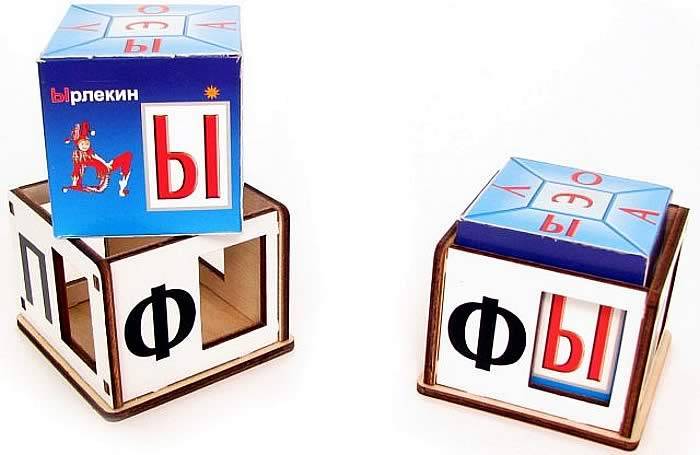
Voskobovich's technique is not just games. This is a flight of fancy, fabulous stories and excellent preparation for school. Together with your child, come up with new adventures for heroes, and let development bring you only joy.
Website of psychologist E.V. Pyatashova
A new item has appeared in my games file - the educational game “Transparent Square” by V.V. Voskobovich.
The game is aimed at developing creative and sensory abilities, as well as various mental processes: perception, attention, memory, thinking, and speech. Recommended age: 3-9 years.
This is what it looks like from the outside:
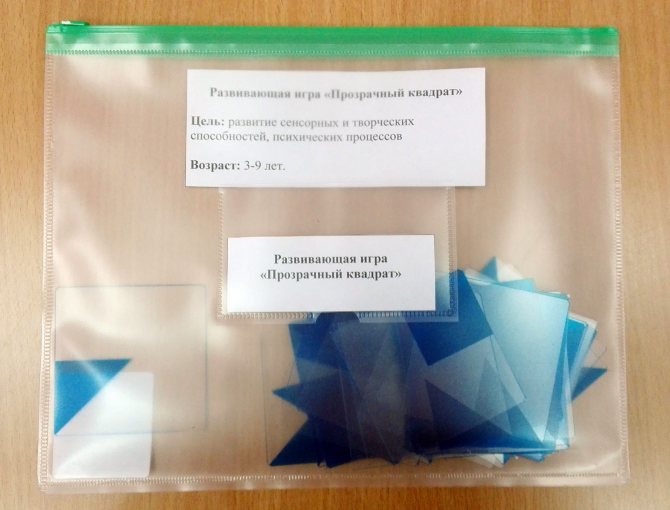
And here it is inside:

The game consists of transparent plates depicting various geometric shapes. Some occur once, others up to 9 times. Interestingly, the design is also visible on the reverse side, only in a mirror image.
First, the children of employees (schoolchildren) got acquainted with the game:
They submitted their ideas to the Transparent Idea 2018 competition
Currently, there is an active testing of the use of the manual in working with preschoolers with SLD.
Transparent square - multivariate constructor . And a whole card index (album of figures) allows you to use the game within the framework of each lexical topic (wild and domestic animals, wintering and migratory birds, etc.).
“Transparent Square” is not only a construction set.
In the correctional and developmental work of a teacher-psychologist, the following options for using the manual are possible:
Game "Find a Pair".
The goal is to choose a pair for the figure (development of visual perception, visual attention, sensory development (shape, size).
Age: from 3 years old.
Game "Fold the square"
The goal is to put together a square from identical or different parts (development of visual perception, visual attention, thinking (synthesis), formation of “part-whole” concepts).
Age: from 4 years old.
Game "Mirror"
The goal is to mirror the figure on the plate (development of visual perception, attention, thinking).
Age: from 5 years old.
Game "Fold 1"
The goal is to choose from the proposed options the one that results when connecting (end-to-end or overlapping) the images on the first two plates) (development of logical thinking). In the future, you can invite the child to choose the appropriate option from a variety of squares.
Age: from 5 years old.
Game "Fold the figure 2".
The goal is to choose from the proposed options the one that needs to be connected to the figure on plate 1 (end-to-end or overlapping) to get the figure on plate 3 (development of logical thinking). In the future, you can invite the child to choose the appropriate option from a variety of squares.
Age: from 5 years old.
Game "Find the extra piece."
The goal is to find a figure that differs from others in some way, to explain the choice (formation of mental operations (exclusion).
Age: from 4 years old.
A variant of the task for this game is to swap the plates.

A variant of the task for this game is to unfold the plates in space.

Game “Fold the image”
The goal is to put together any image from 2 or more plates according to the child’s intention (development of thinking, imaginative imagination).
Age: from 5 years old.

Game "What has changed?"
The goal is to find differences in the series from the original sample (development of visual perception, visual attention, visual memory).
Age: from 4 years old.
Initial sample
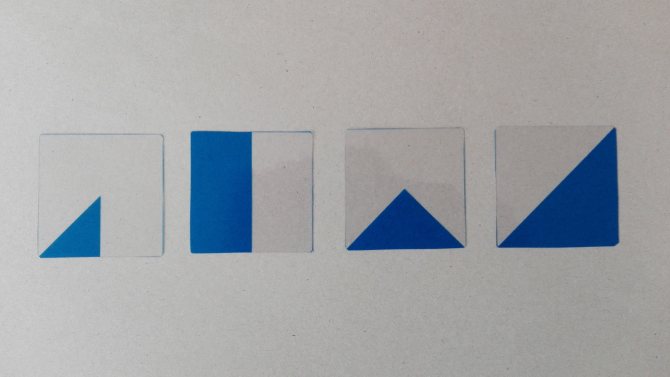
Change option (swap the plates)
Change option (we change the location in space)
Change option (who hid?)
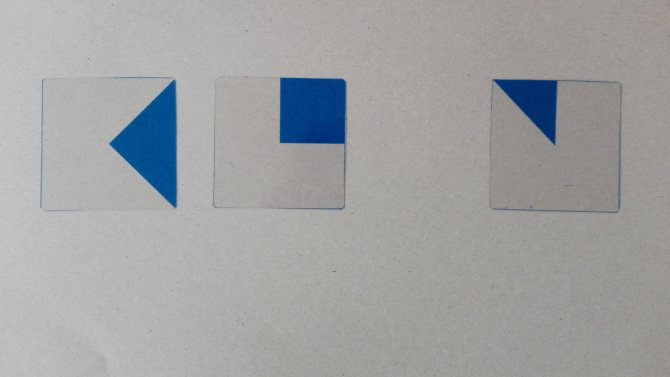
Thus, this educational game can be used in individual and subgroup correctional and developmental work in preschool educational institutions, as well as work with gifted preschoolers (my project). It is interesting for children of all age groups of preschool educational institutions and is very effective in the development of all mental processes (especially thinking). I recommend!!!
How to play
It must be remembered that an adult is a full partner in playing with a child. You can easily take this toy on your trip; it will keep your child occupied for a long time and takes up minimal space in your luggage.
To play with Voskobovich's magic square, you can use the book “Square Fun,” which is included in the package and offers a fairy tale story with 18 color addition patterns. The fairy tale “The Mystery of the Raven Meter” with its main characters mom Trapezium, dad Rectangle, baby Square, grandfather Quadrangle and other characters will captivate your child into the world of adventure. He will happily agree to help overcome the difficulties that stand in the way of the heroes.
You can turn on your imagination and dream up with your child. Come up with your own fairy tale and your own schemes. You can create your own book in which your fairy tales will be written down and pictures drawn up together with your child, from which he can recreate the figures again. This game will be even more interesting for him.
You can suggest counting how many planned figures are in the square. In this case, it is necessary to count composite figures too. You can count triangles, squares, rectangles...
Play the game "Guess what happened." To do this, fold some shape and ask your child to guess what happened. If the child already knows how to fold figures independently, then switch roles. Now he will put together a figure for you, and you guess.
You can create an unusual finger theater by playing only individual parts of the square. Let the child lift up the upper left corner with his finger, the lower left corner, the upper right, the lower, and now, lifting the center of the square from below with his finger, he will get a pyramid. This game will be fun to play with musical accompaniment.
The square can be cut in certain places. For example, by cutting a square with a cross, you will discover new possibilities for folding unusual three-dimensional shapes.
Fantasize with your baby and you will be able to discover new games with this wonderful square.
How to use the toy
The Voskobovich square is a funny thing even for parents. In some ways it resembles origami, in some ways it resembles paper clamshell toys from our childhood. You can watch a master class on the Internet on the topic of using the toy, but I suggest using your own imagination first. So what can you do with a square?
- Try to count all triangles (even compound ones), as well as squares and rectangles. You will be surprised, but this is a really exciting activity.
- Try intuitive additions. Show your child how to fold a square to make a house, candy, triangle or small square, and then let the child try to fold something himself.
- Use different patterns to assemble ready-made square figures.
- Offer your child a game to develop their imagination - a banal guessing game. Take turns making some figures out of the square so that the other person can guess what happened.
- Be sure to invite your child to add up any symbols or letters that are familiar to him.
As soon as the toy becomes clear, it immediately turns into a favorite. Use recognizable elements to develop your baby's interest.
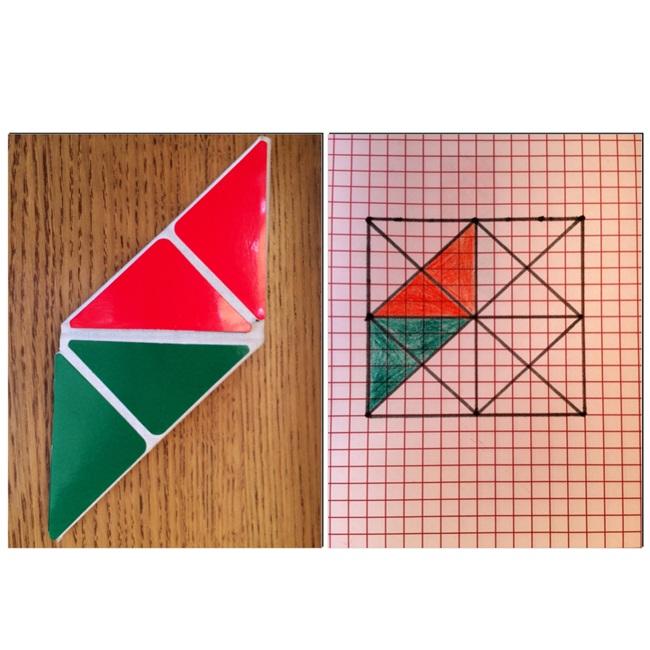
Game Features
- Developed in accordance with the interests of the children. They do it with pleasure. Kids are constantly discovering something new, previously unknown.
- Each game can be used by children of different ages, ranging from 2 to 7 years. Simple tasks are prepared for kids; for older children, the tasks become more complicated. The older the child, the higher the level of difficulty.
- Multifunctionality and versatility. Each game involves solving many learning problems and contributes to the comprehensive development of children and the manifestation of creative abilities.
- The proposed ready-made didactic material is systematized by age and educational objectives.
- For many games, a methodological manual is offered, in which you can already take a ready-made fairy tale plot with tasks, illustrations and questions included in it. This point is key in Voskobovich’s technology. The adult will act as a full partner of the baby, regardless of age.
- High variability. The games offer many tasks, ranging from manipulation to complex developmental exercises.
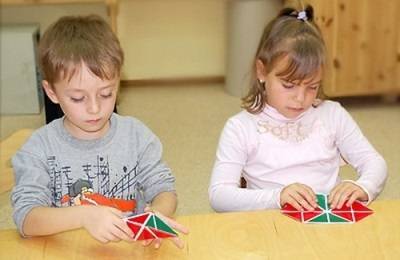
A few notes
I think many people are interested in this toy, so I’ll share my own observations. Games using the Voskobovich method should be used with children starting from two years old. At first these will be the simplest manipulations - the baby will fiddle with a nice bright square, learn to fold it, but every year the game will become more complicated.
Gameplay allows children to do things on their own. This develops responsibility and also gives complete satisfaction from the learning process. At the age of 2-4 years, it is very important to consolidate the positive effect of learning, then in the future it will be much easier to get used to the teaching and educational process.
It is best to use educational games together with a teaching aid - there are illustrated fairy tales, various folding algorithms that will help diversify the process.
With your own hands: is it possible?
Original kits can be quite expensive. Each game is created by hand, thoroughly thought out and tailored to the needs and goals of a child’s specific age. Many parents are interested in creating a replica of Voskobovich's game for preschoolers with their own hands. Most of the kits can be made independently, if you really want to.
It is important that each of your creations:
- safe (no small or sharp parts);
- bright (but without the use of dangerous dyes).
Every mother or father can make Voskobovich’s educational games with their own hands, it’s especially good if they manage to involve the child in the manufacturing process. Such a toy is valued by children hundreds of times more than the purchased one, although it may be slightly inferior in design.
Many of Voskobovich's games are available for free sale. Each game is not just a comprehensive development, but also an excellent fairy tale story, which can be easily expanded by combining sets with each other and changing the fairy tale the way the child wants. Each set comes with instructions for parents. Not a single toy can replace a parent, because everything that children learn comes, first of all, from ourselves.
Master class on making a Voskobovich square with your own hands
There are several options for how to make a square yourself. More details about each.
Option 1
How to do:
- Choose contrasting colors for the triangles. If you are making a two-color square, then red and green sheets of cardboard will be enough. If you decide to make a four-color square, you will need red, green, blue and yellow sheets.
- Draw the required number of triangles on the cardboard. For two-color you need 16 pieces of each color, for four-color - 8 pieces. You can use standard triangle sizes (6*4.5*4.5 cm), or you can make your own.
- Cut out the triangles.
- Based on the size of the triangles, decide on the size of the base. For standard sizes, the base will be 15*15 cm. If you use a different size of triangles, then take into account the distance between them of 0.5-1 cm.
- Glue the triangles together in pairs with contrasting colors: blue-yellow, red-green. There should be 16 triangles in total.
- Next, if you use tape, glue the triangles together on both sides, according to the number of colors chosen for the square.
- If you use film, first measure the dimensions of the base of the square. On the base, arrange the squares in the required sequence. Fold the film along the top border and carefully glue the squares on the other side. You will have a solid base for your square. If you use tape, there will be many connection points.
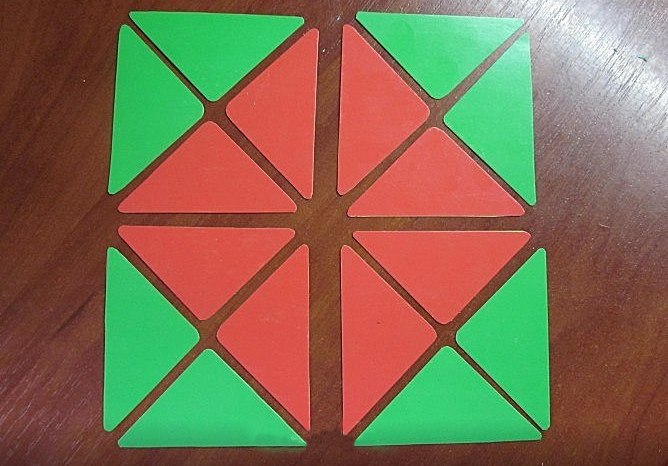
The guide is ready. You can start folding.
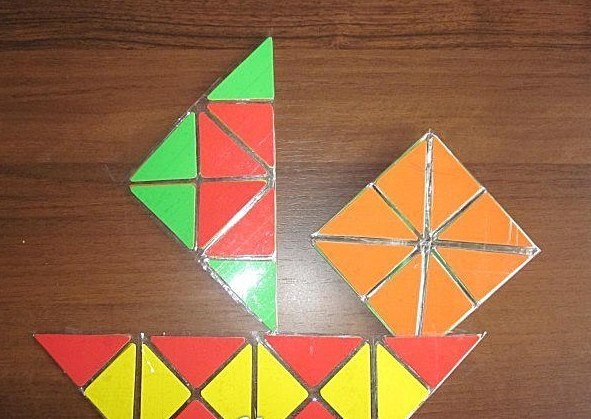
Option 2
You will need:
- plain, easily folded fabric for the base;
- colored self-adhesive paper;
- scissors;
- ruler:
- pencil.
How to do:
Prepare the base of the required size
Please note that the edges of the fabric should not fray. Treat them if necessary. Cut isosceles triangles from self-adhesive paper. Place the triangles on the base to avoid mistakes when gluing. Now gradually separate the protective paper layer from each triangle and glue it to the base.
The dimensions of the triangles and the base, the color combination are described in detail in option 1.
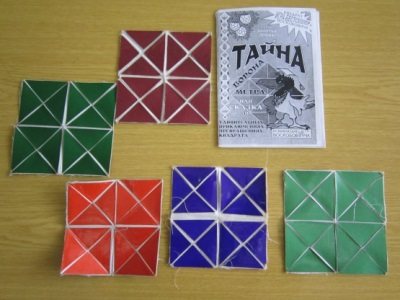
Option 3
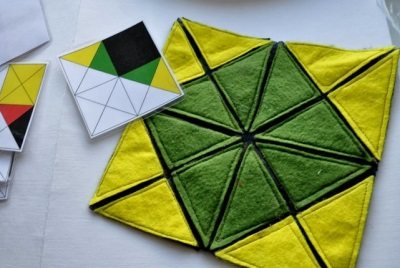
How to do:
- Prepare the base. If necessary, trim the edges of the fabric.
- Cut out the required number of triangles from colored fabric.
- You need to cut out 32 triangles, slightly smaller in size, from cardboard.
- Assembling a square. We glue cardboard triangles onto the base using a glue gun, and glue fabric triangles on top of them.
- To add strength, sew the edges of the triangles using a sewing machine.
All the necessary sizes and color selection can be seen in the first version of the Voskobovich square.
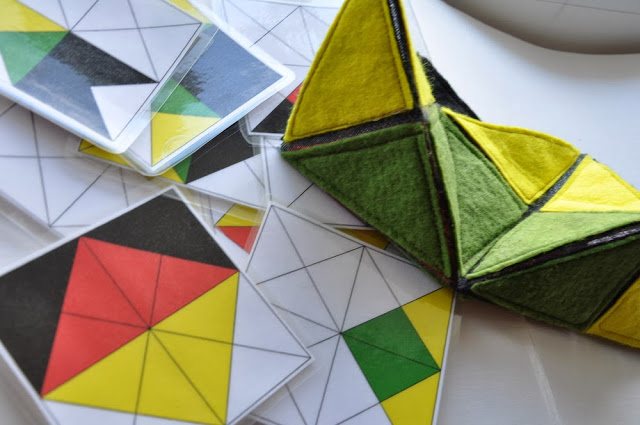
In addition to games with such a square, Voskobovich offers another game “Transparent Square”.
About Voskobovich's technique
Its technology is based on understanding and memorizing acquired theoretical knowledge through practical actions; this is a special path from the practical part to the theory. At the moment, V. Voskobovich has already developed more than 50 games. They are multifunctional creative aids. With their help, your child can learn in a fun and relaxed way.
Voskobovich's games contribute to the comprehensive development of the individual. With their help, the process of learning to read and count goes smoothly and easily. In his methodology, the author pays close attention to the development of children's creative abilities. To complete the proposed tasks, the child will need to be creative and use their imagination.
Based on this, you can see that the technology is developed on 3 most important principles: interest-cognition-creativity.
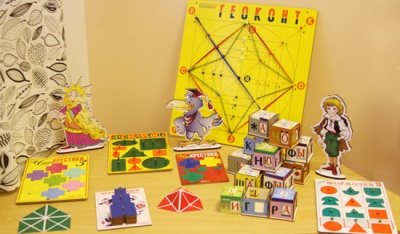
The goals and objectives of his methodology are:
- promote the child’s development of interest and desire to learn new things;
- develop the ability to observe and explore the world around us;
- develop imagination, creative thinking (the ability to look at a familiar object with a completely different look, think flexibly and originally);
- a harmonious approach to the development of children’s emotionality, imaginative thinking and logic;
- provide assistance in the development of mathematical and speech skills;
- form initial ideas about the surrounding reality;
- promote mental development;
- develop fine motor skills.
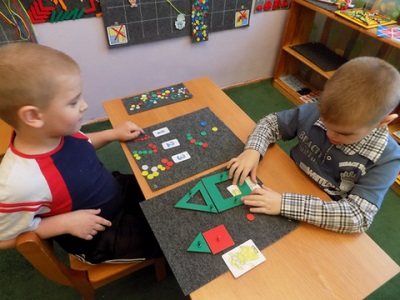
Intelligence
The second principle of the “Fairy Tale Mazes Game” technology is the construction of such children's play activities, as a result of which the mental processes of attention, memory, imagination, thinking, and speech develop. Constant and gradual complication of games (“in a spiral”) allows you to maintain the child’s activity in the zone of optimal difficulty. Intensive development is also facilitated by productive activities carried out in the “zone of proximal development.” In each game, children achieve some kind of “objective” result.
It is no coincidence that much attention is paid to the development of intelligence in preschool children. As a rule, they develop verbal intelligence, that is, “acquired.” The mother reads books to the child, looks at encyclopedias with him, and takes him to museums. As a result, the child knows a lot and has heard a lot. School teachers call such children “trained.” But there is a fly in the ointment in this ointment. There is no guarantee that these children will study well in the future. They may have poorly developed nonverbal intelligence, that is, “innate.” What is innate intelligence? These are mental processes of attention, the ability to analyze, synthesize, the formation of cause-and-effect relationships, fine motor skills, and memory. Psychologists say that developing innate intelligence is difficult. Voskobovich’s games are primarily aimed at their development, and one of the conceptual provisions of the “Fairytale Mazes Games” technology is the development of mainly non-verbal intelligence in children.
The authors of the Fairytale Mazes Game technology are not supporters of early accelerated development of children. All technology material is sensitive, that is, the most favorable, to the psychological characteristics of the development of preschool children, and therefore does not provoke the occurrence of stressful conditions in children and adults.
